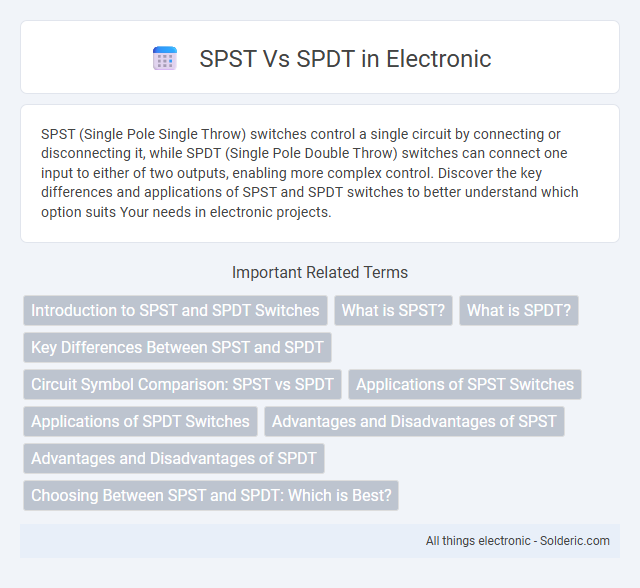SPST (Single Pole Single Throw) switches control a single circuit by connecting or disconnecting it, while SPDT (Single Pole Double Throw) switches can connect one input to either of two outputs, enabling more complex control. Discover the key differences and applications of SPST and SPDT switches to better understand which option suits Your needs in electronic projects.
Comparison Table
| Feature | SPST (Single Pole Single Throw) | SPDT (Single Pole Double Throw) |
|---|---|---|
| Definition | Switch with one input and one output connection | Switch with one input and two output connections |
| Number of Poles | 1 | 1 |
| Number of Throws | 1 (on/off) | 2 (switches between two circuits) |
| Function | Acts as an on/off switch | Directs current to one of two outputs |
| Applications | Simple power control, circuit isolation | Selecting between two signal paths or loads |
| Example Use | Light switch (on/off) | Toggle between two audio sources |
| Contact Arrangement | One fixed and one moving contact | One common terminal connects to one of two terminals |
| Complexity | Simple | Moderate |
Introduction to SPST and SPDT Switches
SPST (Single Pole Single Throw) switches control one circuit with a simple on/off function, ideal for basic electrical applications. SPDT (Single Pole Double Throw) switches manage a single input and toggle it between two outputs, offering greater flexibility for circuit switching. Your choice depends on whether you need basic control with SPST or more complex switching options with SPDT.
What is SPST?
SPST (Single Pole Single Throw) is a basic electrical switch that controls a single circuit with two terminal connections, allowing current to flow when closed and stopping it when open. Its simple on/off functionality makes it ideal for straightforward applications like powering devices or turning lights on and off. Understanding SPST switches can help you choose the right component for circuits requiring binary operation without complex switching paths.
What is SPDT?
An SPDT (Single Pole Double Throw) switch allows one input to connect to one of two outputs, enabling circuit control between two different pathways. Unlike the SPST (Single Pole Single Throw) switch, which only connects or disconnects one circuit, the SPDT switch can alternate between two circuits without breaking the connection. This makes SPDT ideal for applications requiring circuit selection, such as toggling between power sources or output devices.
Key Differences Between SPST and SPDT
SPST (Single Pole Single Throw) switches control a single circuit with an on/off function, whereas SPDT (Single Pole Double Throw) switches can route a single input to one of two outputs, enabling circuit selection or changeover. The SPST switch has two terminals and functions as a simple open or closed switch, while the SPDT switch has three terminals, allowing it to connect the common terminal to one of two others. Key differences include SPST's binary operation versus SPDT's ability to toggle between two distinct output paths, making SPDT suitable for applications requiring alternate circuit control.
Circuit Symbol Comparison: SPST vs SPDT
The SPST (Single Pole Single Throw) switch symbol features a simple break in a single line, representing one input and one output connection. In contrast, the SPDT (Single Pole Double Throw) symbol includes a single input line connecting to a movable contact that can connect to either of two output lines, indicating the ability to toggle between two circuits. This distinction in symbols highlights the SPST's function as an on/off switch versus the SPDT's role in selecting between two paths.
Applications of SPST Switches
SPST (Single Pole Single Throw) switches are commonly used in simple on/off control circuits, such as lighting systems, basic appliances, and power tools, where straightforward power interruption is needed. These switches are ideal for applications requiring a single input and output path, making them suitable for controlling devices like lamps or fans. You will find SPST switches extensively used in residential wiring and simple electronic projects due to their ease of use and reliability.
Applications of SPDT Switches
SPDT switches are commonly used in applications requiring the control of two circuits with a single switch, such as selecting between two power sources or toggling signals in electronic devices. These switches enable you to route current from a common terminal to one of two outputs, making them ideal for audio equipment, lighting control, and motor direction control. Their versatility in switching between circuits ensures efficient performance in complex electrical systems.
Advantages and Disadvantages of SPST
An SPST (Single Pole Single Throw) switch offers simplicity and reliability, making it ideal for basic on/off control with minimal wiring and low cost. Its main disadvantage is limited functionality, as it can only control a single circuit without the ability to switch between different paths. If your application requires straightforward operation without complex switching, an SPST switch provides an efficient solution.
Advantages and Disadvantages of SPDT
SPDT switches offer the advantage of controlling two different circuits from a single input, making them ideal for applications requiring a single-pole double-throw configuration, such as selecting between two power sources or outputs. Their main disadvantage lies in increased complexity and cost compared to SPST switches, as well as potential reliability issues due to added moving parts. Your choice of SPDT switches can enhance circuit flexibility but may require careful consideration of these trade-offs in design.
Choosing Between SPST and SPDT: Which is Best?
When choosing between SPST and SPDT switches, consider your circuit's needs: SPST (Single Pole Single Throw) switches provide simple on/off control, ideal for basic applications where only one connection is required. SPDT (Single Pole Double Throw) switches offer more versatility by allowing you to toggle between two separate circuits, making them perfect for selecting different power sources or routing signals. Your choice depends on whether you need straightforward single-path operation (SPST) or flexible switching between two paths (SPDT).
SPST vs SPDT Infographic

 solderic.com
solderic.com